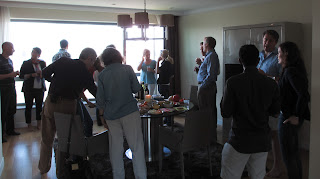First step was to source some experience!
My first thought was to try and obtain a copy of the Bourke St Bakery cook
book. A bit difficult when you’re based in UB. But there appeared to be a few
sections replicated on various blogs, and also a kindle version, which I was
hoping someone could purchase for me.
At drinks on Friday night, I mentioned my
idea, and was incredibly fortunate to find that Houston, OT's Media and Communications guru is
a devout baker! Baking has been the source of many a great moment in Houston's life. He candidly described time when he used baking to
help woo his girlfriend’s family - an ornate, difficult loaf, especially for an important family occasion. The love of good, tasty bread appears universal.
Luckily, Houston also offered to lend me he two favourite bread books: Tartine and (the obviously named) Bread.
Houston explained that Tartine was a book for
inspiration. Written by Chad Robinson, the baker from the famous sourdough bakery in
Sanfrancisco, and accompanied with photographs from his long-time surfing friend, it provides simple
instruction and beautiful images to lead you from baking a perfect country
loaf to more sophisticated loaves, all based from the one core recipe.
The book starts
with a moving story of Chad’s journey from culinary school, to his first
apprenticeship, then France and
the Alps with his partner, pastry chef Elizabeth Prueitt, to returning to
San Fransciso, and commissioning an oven to be built next door to his house.
Baking has been a lifelong passion for him and his partner; it is a story of learning and hard work, but in a positive way, driven by a vision for a perfect rustic loaf and building a local bakery. It is hard to
be swept up in his story and begin a sourdough starter straight away.
In contrast, Bread is a book for technical learning and is a story of “breadth”. It shows you how to read bakers recipes using percentages, understand the protein content of different flours, measure, mix and shape a loaf in the most detailed, and scientific manner. It makes baking seem more of a process, to be followed strictly, rather than an art. It appealed to the questioning chemical engineer inside me.
Both books are complimentary, but offer
different perspectives. I had a flick through them on Sunday.
Houston suggested I start with a poolish (French for Polish) from the technical guide, and make a simple french loaf to work
on my technique, whilst simultaneously creating a starter (leavener). Using a Poolish, or pre-ferment, takes some of the waiting out of the process of making a sourdough. The night before you intend to bake you mix equal quantities of water and flour (protein content >12.5%) with a small amount of yeast. The difference between a Poolish and a Sourdough starter is that a Poolish uses introduced yeast for fermentation, whereas a Sourdough uses the wild yeasts in the flour (and consequently takes longer to establish). My aim for this week is to
attempt this loaf!



























